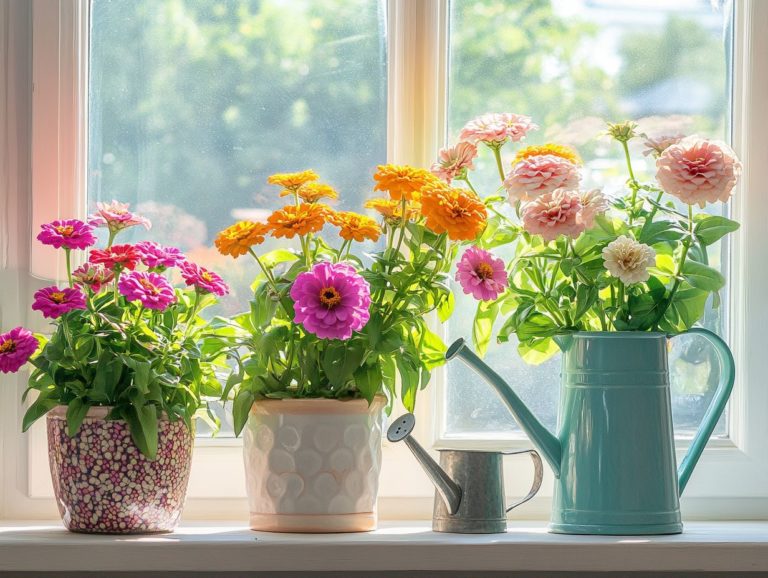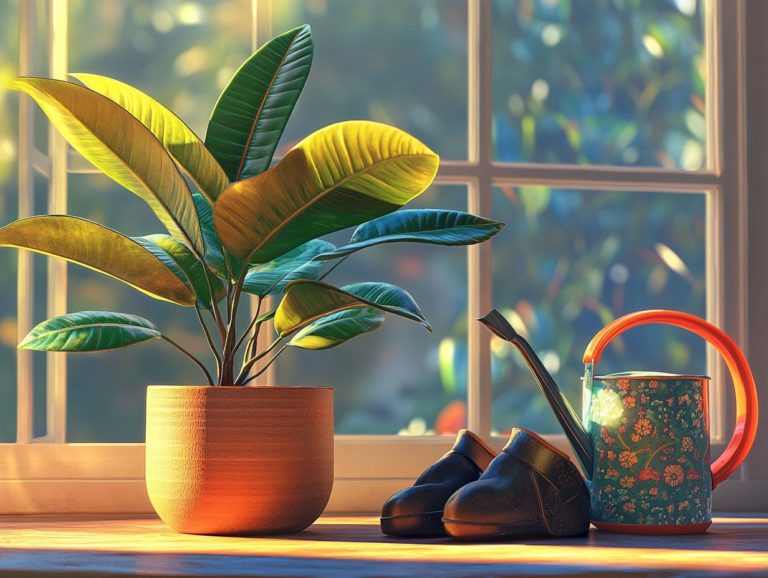Caring for Calathea: A Guide for Homeowners
Calathea plants, also called prayer plants, are loved for their stunning leaves and unique patterns. They are a favorite choice for indoor gardens.
This guide will help you choose the best Calathea for your home. You ll learn how to grow different types and their specific care needs.
Explore key topics like Calathea light, watering, and humidity. You’ll also find solutions for common challenges, including pests and diseases.
You ll discover valuable tips for growing, pruning, and propagating these beautiful plants. Make sure your Calathea thrives in your space!
Dive in and learn how to bring the enchanting beauty of Calathea varieties into your home!
Contents
Key Takeaways:
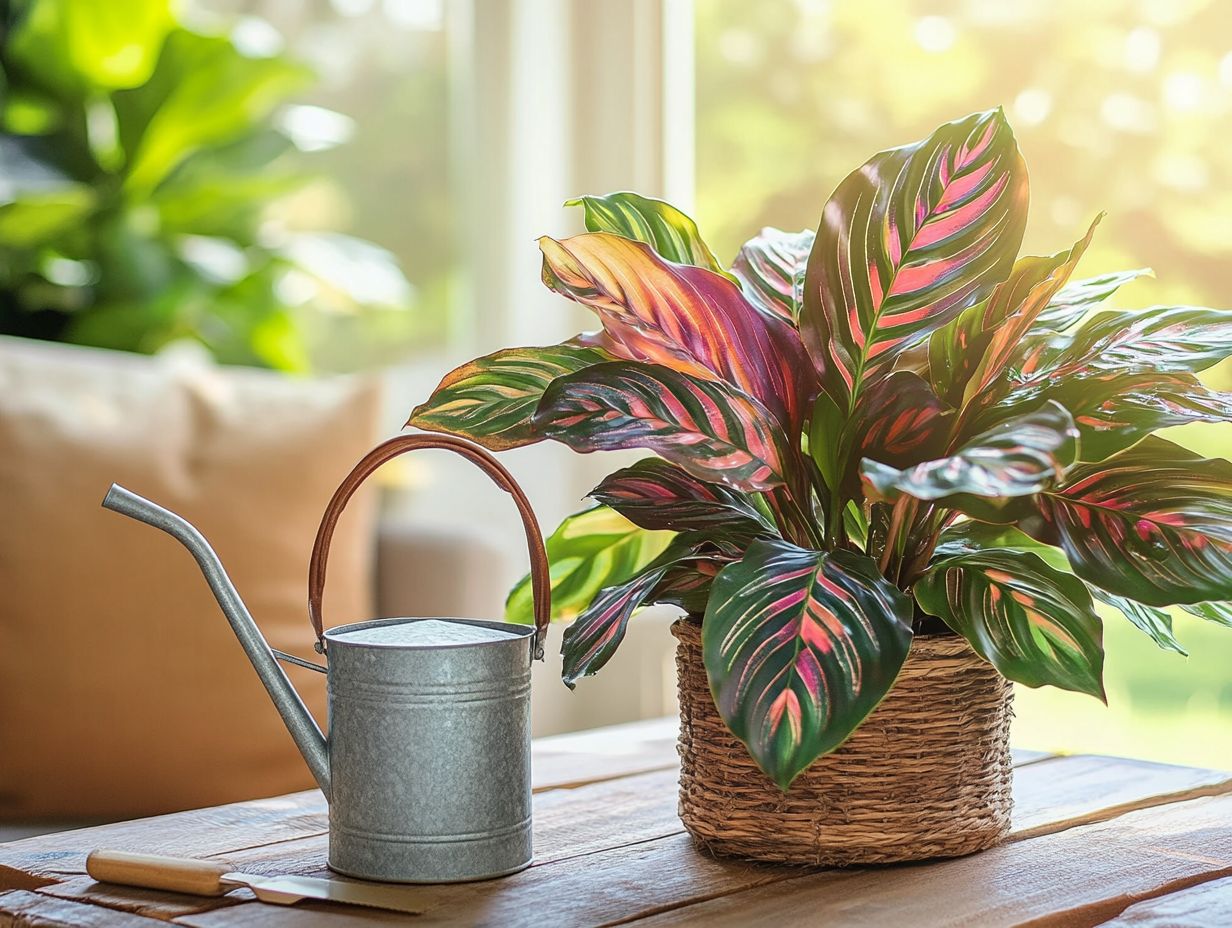
- Choose the right Calathea by considering its light and temperature needs.
- Ensure proper care with the right light, humidity, and watering techniques.
- Use good maintenance and propagation methods to keep your Calathea healthy and vibrant.
Discover the Magic of Calathea!
Calathea, a captivating gem from the Marantaceae family, also known scientifically as Goeppertia, is often dubbed the prayer plant for its enchanting ability to fold its leaves at night, echoing the gesture of prayer. Hailing from the lush tropical rainforests of Central America and South America, Calathea is adored for its colorful leaves and intricate patterns, making it a favorite among indoor plant aficionados.
With various types like Calathea zebrina, Calathea orbifolia, and Calathea crocata, each showcases a unique charm, enhancing its appeal as a pet-friendly addition to your home decor.
These plants do more than just beautify your space; they also serve as exceptional plants that clean the air, contributing to a healthier living environment. The striking colors and diverse markings of Calathea leaves ranging from silvery greens to deep purples allow them to seamlessly blend with a variety of interior styles, whether you lean towards bohemian or modern minimalist. Their unique nature and care requirements make understanding Calathea needs essential for any plant lover.
Caring for a Calathea is an exciting adventure that can transform your space! They flourish in humidity for Calathea and indirect light, making them ideal companions for anyone seeking to elevate their home s atmosphere. Their significance in the plant community also lies in their ability to uplift mood and aesthetic, offering a serene and calming presence that you can t help but appreciate.
Choosing the Right Calathea for Your Home
Selecting the perfect Calathea varieties for your home requires a deep appreciation for the diverse array of varieties available and how they can meet your specific aesthetic and care preferences.
With options like Calathea crocata, Calathea White Fusion, Calathea Dottie, and Calathea Freddie, each variety showcases its distinctive charm and allure. It s crucial to consider factors such as Calathea light, humidity, and available space before making your choice, ensuring that your selected plant thrives in its new environment.
Factors to Consider
When choosing a Calathea for your home, it s essential to consider its light requirements, humidity preferences, and overall care needs to ensure it flourishes. Calathea loves filtered light and thrives in high humidity, making it perfect for spaces like bathrooms or kitchens.
Understanding the specific needs of various Calathea varieties, such as Calathea lancifolia, is crucial for creating the right environment for its health and vitality.
Proper placement is key. Keeping it away from direct sunlight is vital, as too much brightness can lead to unsightly leaf burn. For example, Calathea orbifolia craves moisture in the air and appreciates a little periodic misting to replicate its natural tropical habitat.
Don t forget about soil composition using well-draining potting mix enriched with organic matter is a must to prevent root rot, a condition that occurs when roots sit in too much water, causing them to decay. By regularly monitoring the plant s environment and adjusting your care routine, you ll cultivate a vibrant addition to your indoor space.
Caring for Calathea
Caring for Calathea demands a nuanced understanding of its unique requirements, such as watering, soil preferences, and avoiding common missteps like too much water.
To keep these exquisite plants in peak condition, it s essential to utilize well-draining soil and offer filtered water. This allows them to absorb the moisture they desire while preventing root rot.
Regularly monitoring soil moisture levels will enable you to achieve the ideal balance, fostering a thriving Calathea that enhances the beauty of your home.
Light and Temperature Requirements
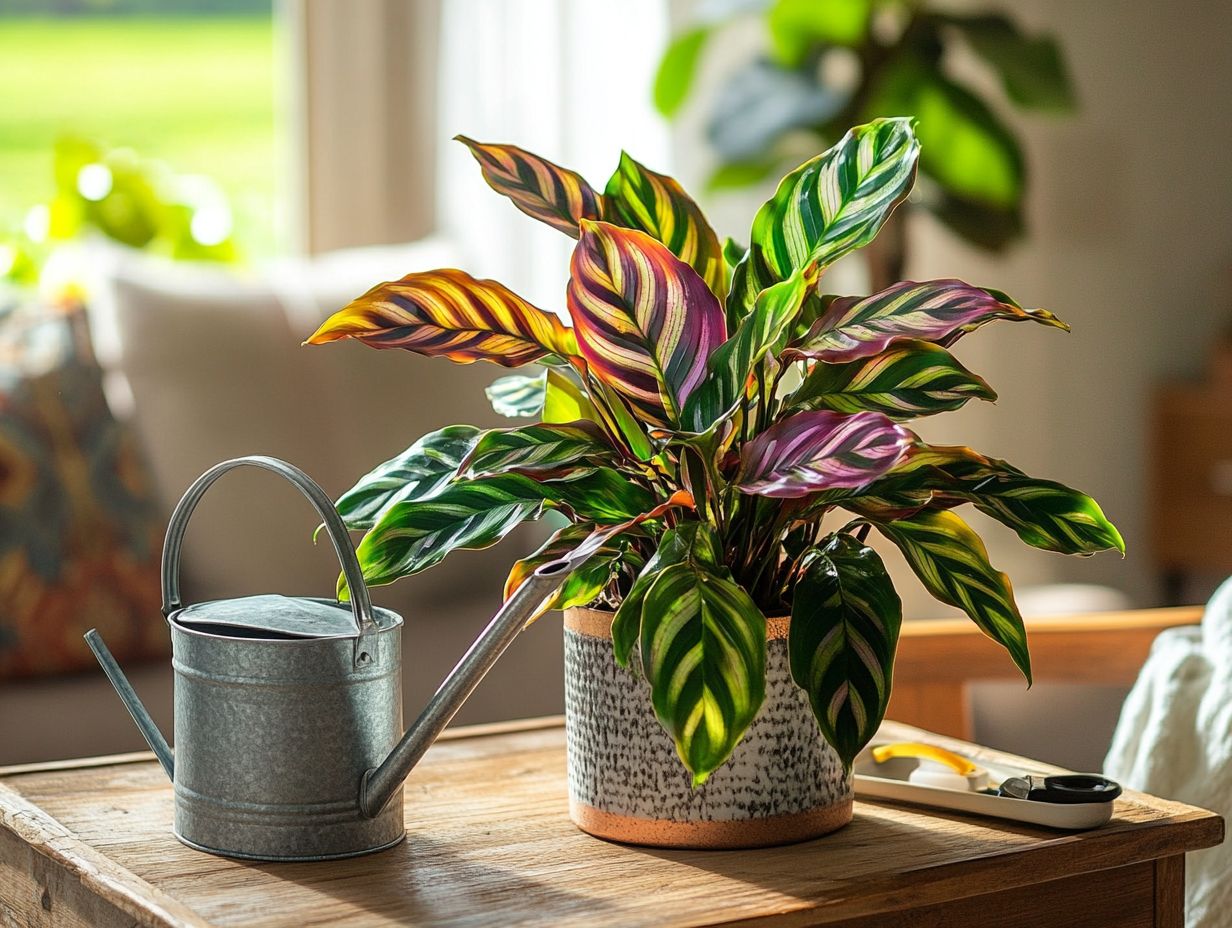
Calathea plants truly thrive in bright, indirect light. Position them where they can bask in optimal illumination without the harshness of direct sunlight, which can scorch their delicate leaves.
Keep temperatures between 65 F and 80 F (18 C to 27 C) for best results. Extreme temperatures can stress them and hinder growth, impacting overall care.
The right lighting keeps Calathea s vibrant colors healthy. If placed in a dim area, they might become leggy or lose their unique markings, signaling that they crave brighter surroundings.
If they get too much direct sunlight, you ll notice burn spots and leaf curling. Finding that perfect balance is key to their well-being. Any fluctuations outside their preferred range can stunt growth and lead to leaf drop or browning tips.
Watering and Humidity Needs
Watering is a crucial element in your care regimen. It’s vital to keep the soil consistently moist while avoiding waterlogging, which can lead to too much water. This plant thrives in high humidity, ideally between 40% and 60%.
Consider using a humidifier or placing the pot on a tray filled with pebbles and water to maintain those essential moisture levels.
To determine the optimal watering frequency, check the top inch of the soil. If it s dry, it s time to give your plant a drink. Generally, you might water about once a week, but temperature and light can influence this schedule.
Opt for distilled or rainwater to avoid the chemicals found in tap water. Misting the leaves is another effective way to boost humidity and keep your Calathea happy.
Pay close attention to signs of dryness or drooping leaves. This feedback is invaluable in understanding your Calathea s needs, ensuring it remains vibrant and thriving!
Soil and Fertilizer Recommendations
Selecting the right Calathea soil is essential for the health of your Calathea. A well-draining, rich potting mix is ideal for promoting healthy root growth. It also prevents pesky water retention.
Regular fertilization during the growing season can elevate your Calathea care. This allows it to thrive and reach its full potential in your home, enhancing the beauty of your indoor garden.
A mix that includes components like peat moss, perlite, and orchid bark will create the optimal environment for your plant. This combination ensures adequate air circulation and moisture without becoming overly soggy.
Keep in mind that these tropical beauties prefer slightly acidic to neutral pH levels, which means the soil should not be too acidic or too alkaline for proper Calathea care.
Using a balanced liquid fertilizer every few weeks during spring and summer provides essential nutrients. It also supports vibrant leaf growth and enriched coloration for your Calathea. This attention helps your Calathea remain a stunning focal point in any room.
Common Problems and Solutions
Common challenges that can impact your Calathea include Calathea pests, diseases, and environmental stressors. These may manifest as browning leaves or wilting.
Identifying and addressing these concerns promptly is crucial for maintaining the plant’s vitality. By regularly inspecting for pests like spider mites or aphids, you can effectively prevent a host of issues.
Keep your Calathea thriving by addressing any problems quickly!
Pest Control
Pest control is essential for ensuring the health of your Calathea. Common pests such as spider mites, aphids, and mealybugs can cause significant damage if not addressed promptly. Make it a habit to inspect your Calathea plants regularly for these unwelcome guests.
Utilizing methods like neem oil or insecticidal soap can effectively manage infestations and keep your Calathea thriving. Recognizing the early signs of these pests is key to prevention.
For example, spider mites often leave fine webbing on the undersides of Calathea leaves. Aphids tend to gather on new growth, feasting on sap and causing curling. Mealybugs, with their distinctive white, cottony appearance, are usually found in the leaf joints.
To combat these nuisances, consider introducing beneficial insects like ladybugs for natural control. Regularly wipe the Calathea leaves to physically remove any pests.
Maintaining optimal humidity levels is another effective strategy to deter these pests. This creates a flourishing, pest-free environment for your Calathea to thrive.
Disease Management
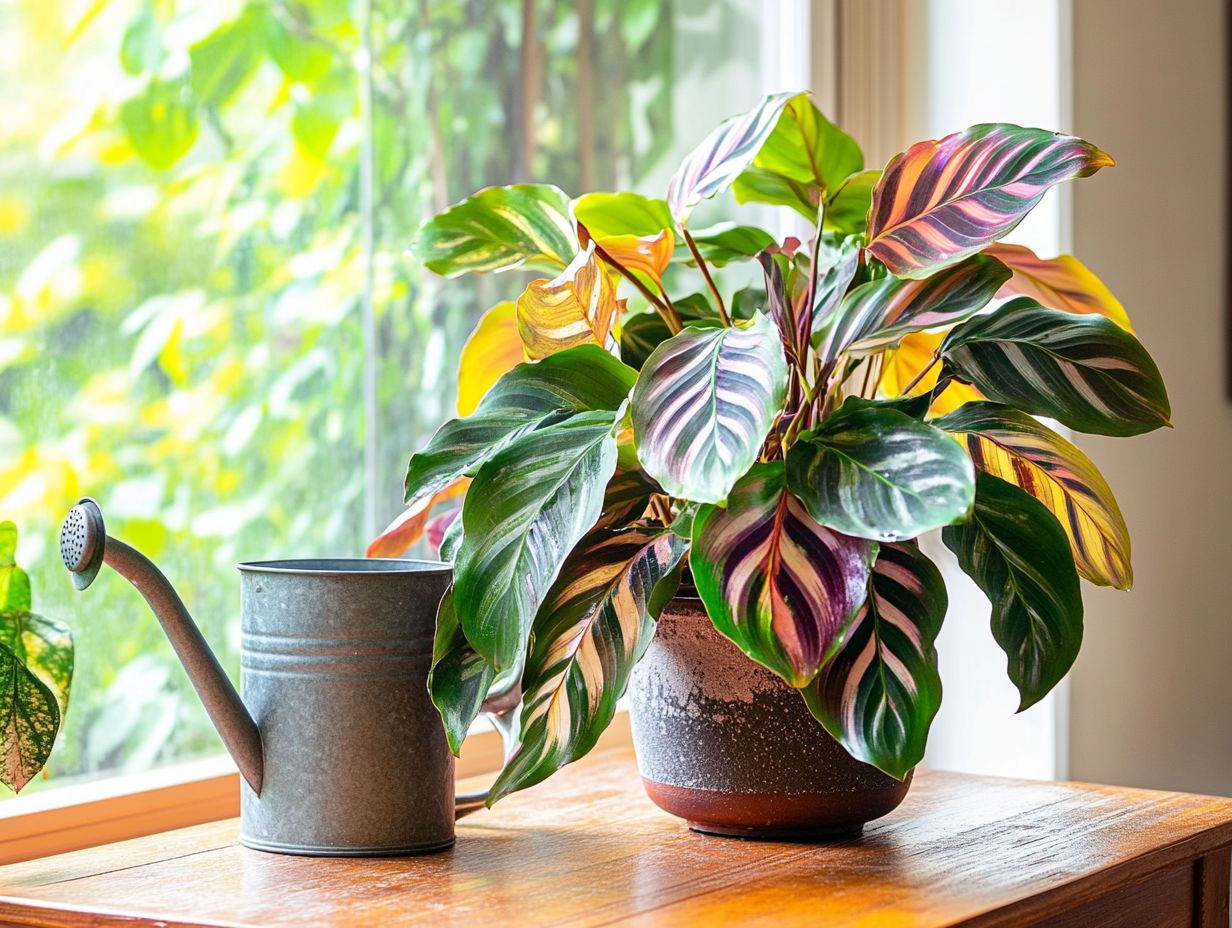
Calathea can be quite sensitive to various diseases, especially when the environmental conditions aren’t just right. This sensitivity may lead to frustrating issues like leaf spots or root rot.
By implementing good watering practices, ensuring proper drainage, and maintaining optimal humidity levels, you can significantly mitigate these problems and promote vibrant growth.
Inconsistent watering and exposure to drafts can worsen these challenges. Common issues, such as powdery mildew, often arise from high humidity combined with poor air circulation. This creates a perfect environment for fungal infections, which are diseases caused by tiny organisms that thrive in damp conditions.
To prevent these conditions, ensure adequate airflow and consider occasionally rotating your plant. Regularly inspecting the leaves for signs of pests allows for early intervention, which is essential for maintaining the overall health of this stunning Calathea plant.
Using organic insecticidal soap can be a highly effective method for managing any infestations that may occur.
Pruning and Propagation Techniques
Pruning and propagation techniques are crucial for maintaining the vibrant health of your Calathea, a member of the Marantaceae family. By mastering these methods, you can expertly manage its size and encourage fresh growth.
Regularly pruning will allow you to eliminate any dead or yellowing leaves, keeping your plant looking its best. Meanwhile, Calathea propagation through division or cuttings offers a wonderful opportunity to expand your collection of these stunning plants.
Don t wait start inspecting your Calathea today and ensure it stays healthy and beautiful!
How to Maintain Healthy Growth
To maintain healthy growth in your Calathea, be consistent with your care practices. Focus on proper watering, humidity, and light exposure tailored to your specific variety, such as Calathea zebrina or Calathea orbifolia.
Regularly check for signs of stress, like yellowing leaves or sluggish growth. This helps you catch issues early, ensuring your Calathea stays vibrant.
Establish a routine for monitoring soil moisture levels. These plants prefer to be kept consistently moist but not soggy. Using distilled water significantly enhances their well-being since tap water might contain harmful chemicals.
Place a humidity tray nearby or use a humidifier to mimic their native tropical rainforest environment. This promotes lush foliage.
Rotate your plant regularly for even light distribution and to prevent it from leaning toward the light source. Follow these best practices to create an environment where your Calathea flourishes beautifully!
How to Grow New Plants from Calathea
Growing new plants from Calathea can be both enjoyable and rewarding. This allows you to expand your collection while ensuring the health of your existing plants.
The most common method involves splitting the root system during repotting. Each section should have a robust enough root system to thrive independently. Alternatively, you can experiment with stem cuttings to add excitement to your plant care routine.
Timing is essential for successful Calathea propagation. Spring is often the prime season for division, as your plant emerges from its dormant phase, eager to grow. For stem cuttings, select healthy shoots in late spring to early summer for vigorous growth.
Create a warm, humid environment to encourage rooting, paired with well-draining soil. Regularly mist your cuttings or place them in a propagating dome to boost their chances of thriving.
Frequently Asked Questions
What is a Calathea plant?
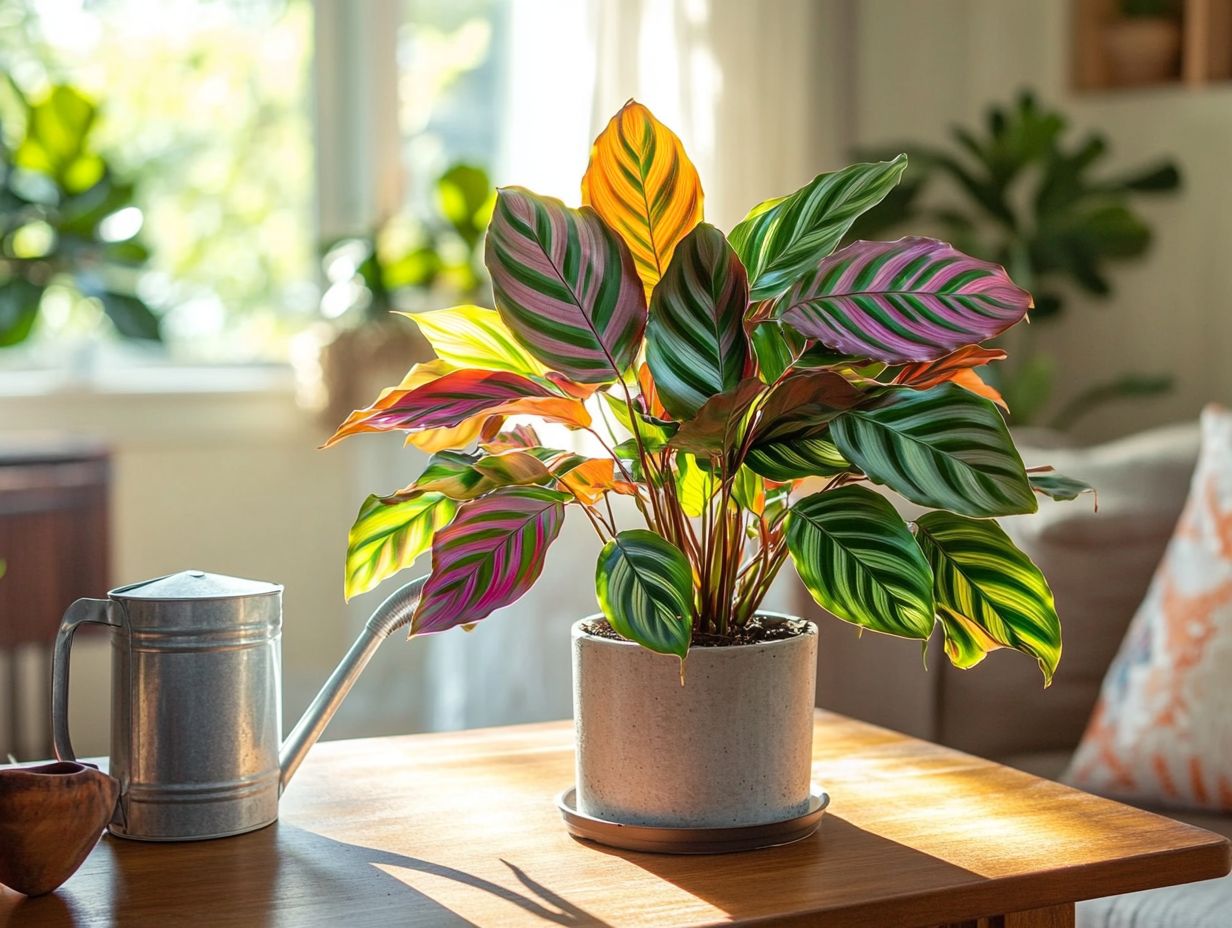
A Calathea plant is a popular houseplant known for its ornamental foliage with intricate patterns and vibrant colors. It belongs to the Marantaceae family and is native to tropical regions in Central and South America.
What is the best way to care for a Calathea plant?
Care for your Calathea by providing indirect sunlight, moist soil, and a humid environment. Regular fertilization and repotting every 1-2 years keep the plant healthy and thriving. Many varieties, such as Calathea Freddie and Calathea Dottie, are pet-friendly.
How often should I water my Calathea plant?
Calathea plants prefer consistently moist soil but not soggy or waterlogged. As a general rule, water your Calathea once a week. This depends on factors like humidity, sunlight, and potting mix. Always check the soil before watering and adjust accordingly.
Visiting places like Le Manoir aux QuatSaisons or Waddesdon Manor can inspire you with beautiful ways to display your Calathea.
Why are the leaves of my Calathea plant turning brown?
Brown, crispy leaves on a Calathea can be caused by underwatering, dry air, or too much direct sunlight. Identify the specific cause and make necessary adjustments to prevent further damage to the plant.
Can I grow new plants from my Calathea plant?
Yes, Calathea plants can be propagated through division or by taking stem cuttings. Division involves separating the plant into smaller clumps with healthy roots and repotting them in fresh soil. Stem cuttings can be taken from the mother plant and rooted in water or soil to produce new plants.
How do I prevent pests from infesting my Calathea plant?
Pests like spider mites and mealybugs often target Calathea plants. Regularly inspect your plant for signs of these pests to catch problems early.
Keep the environment clean and well-ventilated. Treat any pest issues quickly with natural methods, like soap sprays, or chemical solutions if necessary.
Good watering and fertilization habits can boost your plant’s health. A strong plant is less likely to face pest troubles, especially when mimicking its native tropical rainforest conditions.
Act fast to protect your Calathea! A healthy plant is your best defense against pests.

